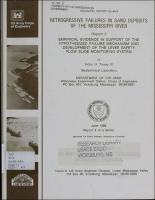Please use this identifier to cite or link to this item:
https://hdl.handle.net/11681/12688| Title: | Retrogressive failures in sand deposits of the Mississippi River. Report 2, Emperical evidence in support of the hypothesized failure mechanism and development of the Levee Safety Flow Slide Monitoring System |
| Authors: | United States. Army. Corps of Engineers. Lower Mississippi Valley Division Torrey, Victor H. |
| Keywords: | Flow slides Mississippi River Bank stability Banks Levees River channels Soils Soil mechanics Retrogressive failure Sands Sandy soils Levee Safety Flow Slide Monitoring System Rivers Liquefaction Celotex failure |
| Publisher: | Geotechnical Laboratory (U.S.) Engineer Research and Development Center (U.S.) |
| Series/Report no.: | Technical report (U.S. Army Engineer Waterways Experiment Station) ; GL-88-9 rept. 2. |
| Description: | Technical report Abstract: This report is the second in a series presenting recent tasks associated with the US Army Engineer Division, Lower Mississippi Valley study, "Evaluation of Potentially Unstable Riverbank Sites Below Baton Rouge, LA, and Selection of Measures to Prevent Failure." The objective of that study is to develop defensive/preventative measures to end the threat to safety of main line flood protection levees below Baton Rouge , LA, posed by flow failures in sand deposits. The case history of a recent large flow failure known as the Celotex slide is presented, analyzed and shown to conform to the current hypotheses concerning the triggering and retrogression of flow failures in sand deposits of the Mississippi River. Additional empirical evidence is drawn from the records of past flow failures to support the current thinking that these failures "run out" in the landward direction on an approximately 10 degree angle from the point of initiation riverward in the scour trench or pool upward to the interface between the cohesive topstratum and sand substratum. This geometric trait then becomes the basis for prediction of the amount of potential foreshore (batture) loss and, consequently, for an assessment of threat to levee stability should a flow failure be initiated at depth out in the scour pool at a given site . The computer data base monitoring system devised by the New Orleans District to perform periodic checks on susceptible sites is presented. The final portion of the report addresses historical river movement and its implications for the reach of river below Baton Rouge, LA. Hydrographic surveys conducted at intervals over the period 1879-1975 were judged to imply trends which may negatively impact levee safety relative to flow slides in the future. Note: This file is large. Allow your browser several minutes to download the file. |
| Rights: | Approved for public release; distribution is unlimited. |
| URI: | http://hdl.handle.net/11681/12688 |
| Appears in Collections: | Technical Report |
Files in This Item:
| File | Description | Size | Format | |
|---|---|---|---|---|
| TR-GL-88-9.pdf | 24.35 MB | Adobe PDF |  View/Open |